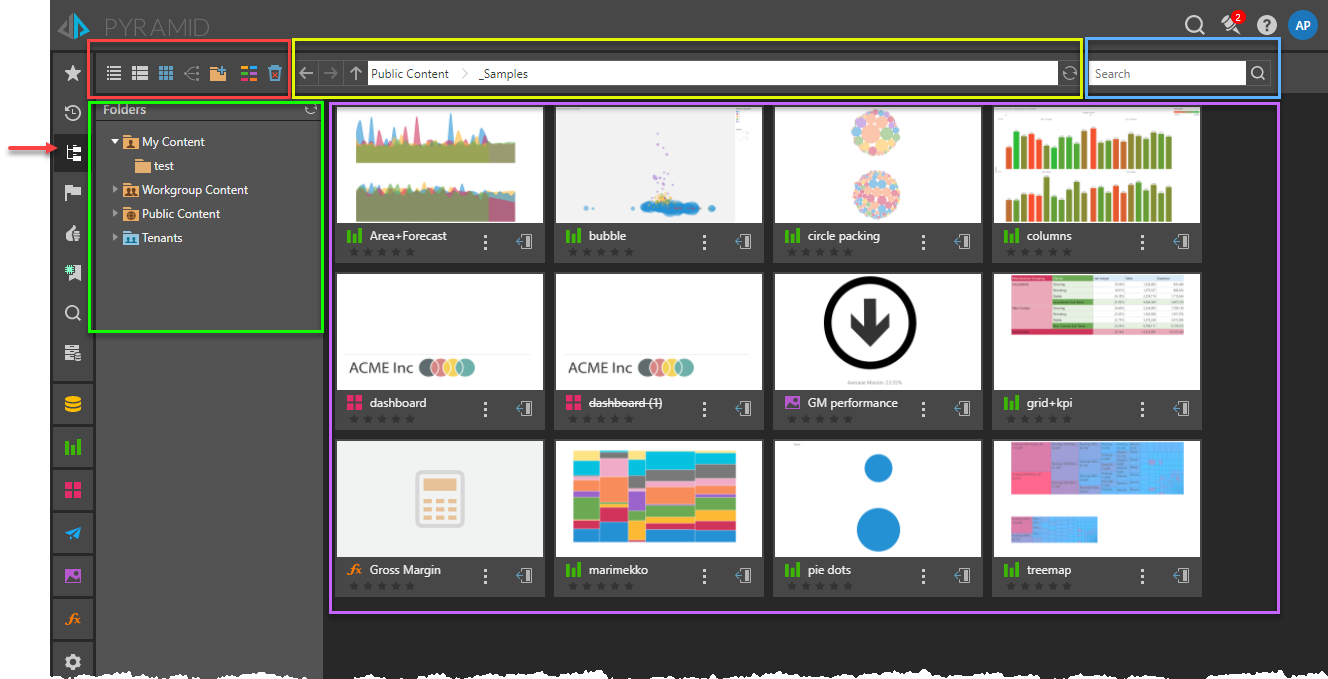The Content Explorer is the master content view for managing content in the pro client content system. It delivers a folder and item interface similar to the Windows Explorer tool - allowing users to organize and manage their content and folders. The Explorer is just one of the ways of viewing content in the content manager toolset - however, it has the richest functionality.
The explorer is usually the default view presented to users if there are no favorites or recent items. This can be configured in the user defaults section.
Explorer Workspace
The 3rd icon in the content manager takes users into the "explorer" view (red arrow below).

Item listing
The item listing (purple box above) is visible in every content view, not just the explorer. This shows a listing of items that match the selections, search, filters etc. The listing contains files of all of the 6 content types (Model, Discover, Formulate, Present, Publish and Illustrate). In the explorer view, it will also contain sub-folders, which are contained within the selected parent folder.
Folder Tree
The folder tree (green below above) shows the 3 core domains accessible to all users on the platform:
- "My Content" - a personal domain of content accessible only to that user.
- "Workgroup Content" - a domain of content accessible to all users who have COMMON roles on the system. In effect, there is a workgroup folder for each role, witch each member of that role having read-write access to content. This is perfect for informal content sharing.
- "Public Content" - a shared content domain that is accessible to users and roles based on a SPECIFIC role assignments by folder and content item.
Admin Access
Admins on the system, have access to another folder domain "Team Member Content" - this is broken down into tenants and users, and allows admins to access each user's private content domain.
Folder Domain Settings
Beyond the standard functionality of the folder structures, admins can also tweak the way they operate across the system using these switches:
- Multitenancy: these switches, including cross-tenant access, control how tenants operate and which folders are presented to users.
- Disabling top-level folder creation: another set of switches to prevent normal users from creating top-level folders
- Blocking Role Specific Workgroup Folders: a switch to prevent a new workgroup folder for each created role.
- Blocking the Workgroup domain for a tenant: a switch to hide the entire workgroup option by tenant.
- Click here for more details on the folder tree structures.
Using the Folder Tree
The folder tree is used as a classic organization tool - and users can copy / paste, cut / paste, delete, secure and export folders as described in more detail here.
Top Navigation Bar
The top navigation bar, which can be seen in various forms across most content views, it is comprised of 3 sections in the explorer view: View switches (red box above); Folder navigation bar (yellow box above); and quick search (blue box above).
Switches
Item Display
- Details View: The detail list shows a grid-like display of content items with various details.
- Content View: This is similar to the detail list but shows small thumbnails of the items.
- Tiles View: This shows all the content items with large tiles and thumbnails.
- Lineage: This button will show the lineage tree for the currently selected item in the listing. Click here for more details on lineage.
Other Functions
- Add Folder: This add a new sub-folder to the currently selected folder.
- Content Type Filter: This button lets the user filter the types of items in a given view that will be shown in the list.
- Deleted Items: This will show or hide (soft) deleted items. This option is available only for enterprise admins. Deleted items are designated by a strike-through over the item name. Note that items that have been purged (hard deleted) are fully removed from the system and will not be shown with this function.
Folder Navigation Bar and Breadcrumbs
From the folder navigation bar users can see the current folder's "breadcrumbs" to better understand where they are in the folder tree. The bar allows users to click on a specific segment of the breadcrumbs to instantly jump to a different parent folder in the tree.
Next to the bar are 3 arrow buttons (on the far left) letting using navigate easily.
- Back and Forward buttons: These buttons act like undo and redo, allowing users to go back and forward to previously selected folders.
- Up button: This button allows the user to simply go up the folder tree structure to the current folder's parent folder.
Quick Search
Quick search (blue box above) lets the user search for items by their name or description WITHIN THE CONTEXT of the current selection. In the explorer view, this means within the current folder and its sub-folders.
Explorer Functions and Actions
The explorer functions are split between those affecting the folder tree (green box) and those affecting the items (purple box). In some cases, there are common actions between these 2 elements while there are also similar actions that behave differently depending on whether the target is a folder or content item. Finally, many of the actions can be accessed from multiple content views in the content manager and are not exclusive to the explorer view.
- Click here for more details on folder related actions and tools.
- Click here for more details on content item related actions and tools.
Item Mechanics
Once items are selected, the various context menus and tools are exposed. This can be done on a single item or on multiple items as a collection - including folders. Click here for more details on item mechanics in the content manager and the different content views.